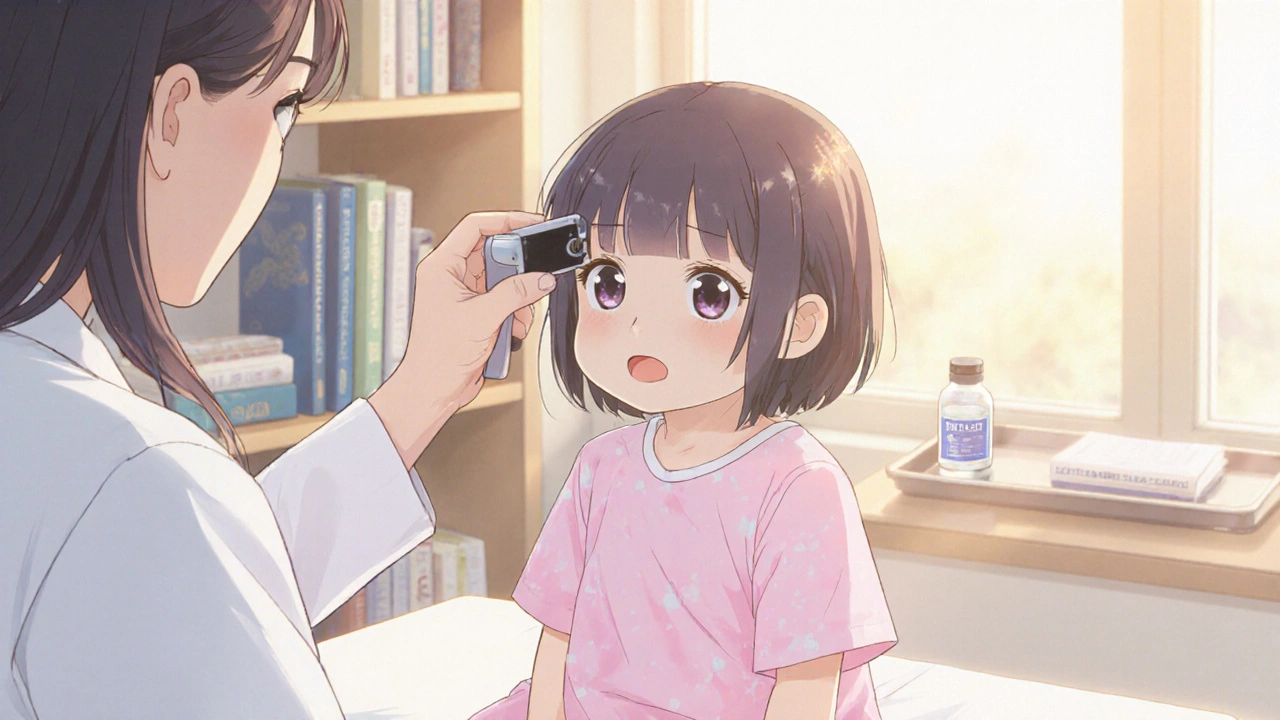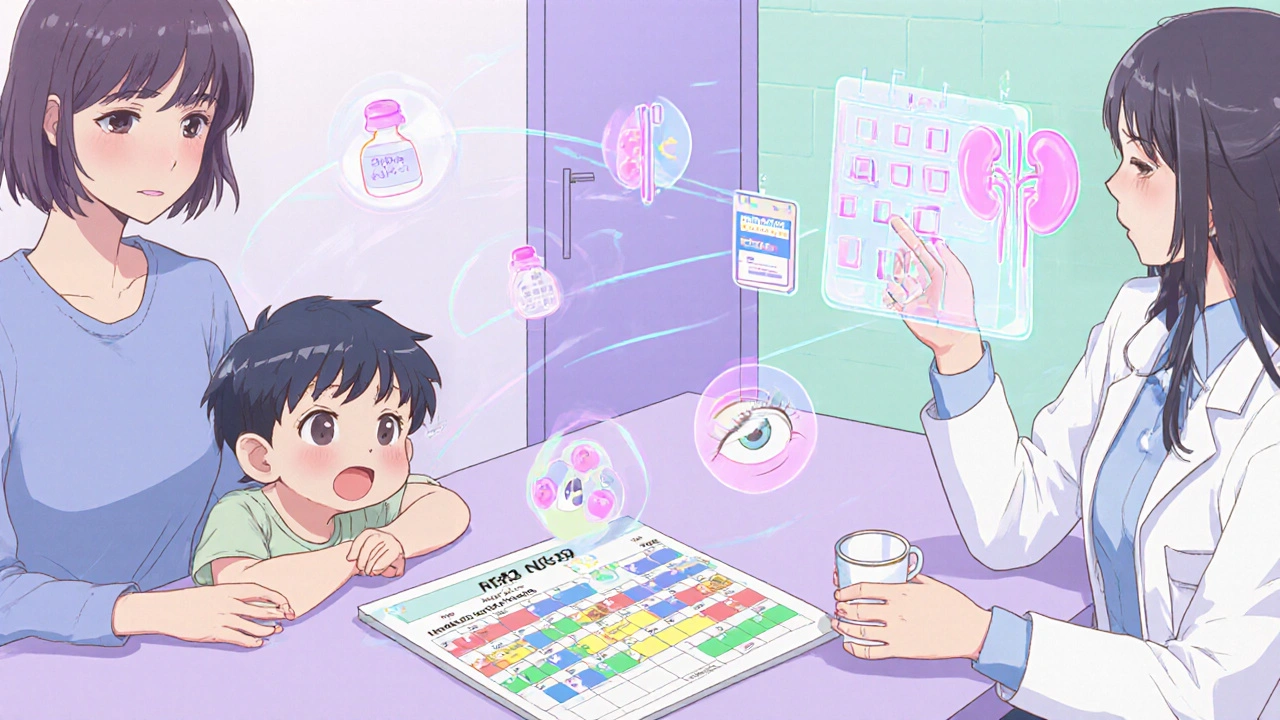Acetazolamide for Pediatric Glaucoma: Complete Treatment Overview

Pediatric Acetazolamide Dosage Calculator
Dosage Calculator
Important Safety Notes
- Typical starting dose: 5-10 mg/kg/day
- Maximum dose: 15 mg/kg/day
- Always check renal function before starting
- Monitor electrolytes during first week
Your Calculated Dose:
Important: This calculator is for informational purposes only. Always consult your child's ophthalmologist for medical advice and treatment. Doses exceeding 15 mg/kg/day may increase risk of metabolic acidosis.
When a child is diagnosed with glaucoma, the first question parents ask is how to bring the eye pressure back to a safe level without harming a developing eye. Acetazolamide is one of the few oral medicines that can do the job, and it has been used for decades in both adults and kids. This guide walks you through what the drug is, why it works for pediatric glaucoma, how to dose it safely, and what other treatment options exist.
Key Takeaways
- Acetazolamide is a carbonic anhydrase inhibitor that reduces the production of aqueous humor, lowering intraocular pressure (IOP).
- Typical pediatric dosing starts at 5‑10 mg/kg/day divided into two or three doses; adjustments depend on age, weight, and response.
- Common side effects include tingling of the fingers, mild metabolic acidosis, and occasional kidney stones; severe reactions are rare but require immediate medical attention.
- It can be combined with topical beta‑blockers (e.g., timolol) or prostaglandin analogues for better IOP control.
- Regular monitoring of IOP, blood electrolytes, and growth parameters is essential during treatment.
Understanding Pediatric Glaucoma
Pediatric Glaucoma is a group of eye disorders in children that lead to elevated IOP, optic nerve damage, and potentially irreversible vision loss. The condition can be primary (congenital) or secondary to other ocular anomalies such as cataract surgery or trauma. Early signs often include cloudy corneas, enlarged eyeballs (buphthalmos), and abnormal eye movements.
Because a child's eye is still growing, uncontrolled pressure can distort the shape of the globe, impair visual development, and cause amblyopia. Prompt medical or surgical intervention is therefore a must.
How Acetazolamide Works
Acetazolamide belongs to the class of Carbonic Anhydrase Inhibitors. It blocks the enzyme carbonic anhydrase in the ciliary body, which reduces the secretion of aqueous humor-the fluid that fills the front part of the eye. Less fluid means lower IOP.
The drug reaches therapeutic levels within 1‑2 hours after oral intake, making it useful for acute pressure spikes. Its effect lasts about 8‑12 hours, which is why dosing is split throughout the day.

Dosage and Administration in Children
Prescribing acetazolamide to a child requires careful calculation based on weight and the severity of the pressure rise.
- Initial dose: 5 mg per kilogram of body weight per day, divided into two doses (morning and evening). For example, a 12‑kg toddler would start with 60 mg total, given as 30 mg twice daily.
- Maximum dose: rarely exceeds 15 mg/kg/day; higher doses increase the risk of metabolic acidosis.
- Formulation: liquid suspension (25 mg/5 mL) is preferred for infants; tablets can be crushed and mixed with applesauce for older children.
- Adjustment: if IOP remains above target after 3‑5 days, increase by 2‑3 mg/kg/day or add a topical agent.
- Tapering: when surgery is scheduled or pressure stabilizes, gradually reduce the dose over 1‑2 weeks to avoid rebound spikes.
Always check renal function before starting therapy because the drug is cleared through the kidneys.
Safety Profile and Side Effects
Acetazolamide is generally well‑tolerated, but pediatric patients may experience age‑specific reactions.
- Common (mild): tingling or numbness in the fingers and toes, metallic taste, mild nausea, increased urination.
- Metabolic: a drop in blood bicarbonate leading to mild metabolic acidosis; monitor serum electrolytes every 2‑3 days during the first week.
- Renal: risk of calcium‑phosphate stone formation; encourage adequate hydration and consider potassium citrate supplementation if stones appear.
- Allergic reactions: rash, fever, or severe Stevens‑Johnson syndrome (extremely rare). Discontinue immediately if these occur.
Children with sulfonamide allergy should avoid acetazolamide because it shares a sulfonamide moiety.

Comparing Common Pediatric Glaucoma Treatments
While acetazolamide is an oral option, many clinicians start with topical medications before moving to surgery. Below is a quick comparison of the most frequently used therapies.
| Treatment | Mechanism | Typical Age Start | Administration | Key Side Effects |
|---|---|---|---|---|
| Acetazolamide (oral) | Carbonic anhydrase inhibition → ↓ aqueous humor production | All ages (weight‑based) | Liquid or tablet, 2‑3 times daily | Tingling, metabolic acidosis, kidney stones |
| Timolol (topical) | Beta‑blocker → ↓ aqueous humor secretion | 3 months + | Eye drops, twice daily | Bronchospasm, bradycardia, sleep disturbances |
| Dorzolamide (topical) | Carbonic anhydrase inhibitor (local) | 6 months + | Eye drops, three times daily | Eye irritation, bitter taste |
| Prostaglandin analogue (e.g., latanoprost) | Increases uveoscleral outflow | 2 years + | Eye drop, once nightly | Darkening of iris, eyelash growth |
| Goniotomy / Trabeculotomy (surgery) | Physically opens drainage angle | Infants‑to‑early‑school age | One‑time procedure | Hyphema, infection, scarring |
Acetazolamide is often used as a bridge to surgery or when topical agents alone cannot achieve target pressure. Its systemic action can be advantageous in bilateral disease where applying drops to both eyes is cumbersome.
Monitoring and Follow‑up
Effective glaucoma care hinges on regular check‑ups. Here’s a practical schedule for kids on acetazolamide:
- Baseline: IOP measurement (tonometry), slit‑lamp exam, optic nerve imaging, serum electrolytes, renal function.
- Week 1: Recheck IOP, review side‑effects, repeat electrolytes.
- Month 1: Full ocular exam, growth chart update, consider adding a topical agent if pressure still high.
- Every 3 months: IOP, optic nerve OCT, visual field (if age‑appropriate), labs.
- Pre‑surgery: Stop acetazolamide 24 hours before if a laser or incisional procedure is planned, to avoid systemic hypotension.
Any sudden increase in eye redness, pain, or vision loss warrants an emergency visit.
Frequently Asked Questions
Can a newborn safely take acetazolamide?
Yes, when the dose is strictly weight‑based and the infant is monitored for electrolyte shifts. Many pediatric glaucoma centers start treatment within the first weeks of life if pressure is dangerously high.
What happens if a child misses a dose?
Give the missed dose as soon as you remember, unless it’s within 4 hours of the next scheduled dose. In that case, skip the missed one and resume the regular schedule to avoid double‑dosing.
Is long‑term oral therapy preferred over surgery?
Surgery offers a permanent solution for many cases, especially in congenital glaucoma. Oral therapy is ideal for acute pressure spikes, as a bridge to surgery, or when surgery is contraindicated. Long‑term systemic medication can affect growth and kidney health, so surgeons usually aim for a definitive procedure when feasible.
How does acetazolamide interact with other glaucoma drops?
It works additively. Combining with timolol or prostaglandin analogues often achieves lower IOP than either agent alone. However, watch for systemic side effects like bradycardia when paired with beta‑blocker eye drops.
Do I need to stop acetazolamide before an eye exam?
No, keep the regimen unless your ophthalmologist specifically advises a wash‑out period for certain diagnostic tests. Stopping abruptly can cause a rebound rise in pressure.
Acetazolamide remains a cornerstone in the medical armamentarium against pediatric glaucoma. By understanding its dosing nuances, safety considerations, and how it fits alongside other therapies, caregivers and clinicians can make informed choices that protect a child’s sight while minimizing systemic risks.

Kevin Hylant
October 22, 2025 AT 16:10Acetazolamide works fast, but you have to keep an eye on the labs. A quick drop in pressure can save vision.
Marrisa Moccasin
October 23, 2025 AT 19:57Wow!!! This oral drug sounds like a secret government experiment!!! Why aren't we warned about hidden side effects??? Is there a cover‑up??
Caleb Clark
October 24, 2025 AT 23:43Let me break down why acetazolamide is still the go‑to for kids with glaucoma – first, the drug hits the carbonic anhydrase enzyme in the ciliary body and that instantly curtails aqueous humor production, which means lower intraocular pressure in a matter of hours. Second, because it’s systemic, you don’t have to struggle with tiny eye drops on both eyes multiple times a day, which is a huge relief for frazzled parents. Third, the dosing is weight‑based, so you can start low, like 5 mg/kg/day, and titrate up if the pressure stays stubbornly high, usually not exceeding 15 mg/kg/day. Fourth, you have a liquid suspension that can be mixed into applesauce for toddlers, making compliance far easier than trying to get a toddler to swallow a tablet. Fifth, you need to check kidney function before starting because the kidneys clear the drug, and you’ll want baseline electrolytes to catch any early metabolic acidosis. Sixth, the side‑effect profile is relatively mild – a few patients get tingling in their fingers or a metallic taste, but those are usually transient. Seventh, if you do see a drop in bicarbonate, you can correct it with oral sodium bicarbonate or just adjust the dose. Eighth, the drug can be combined with topical agents like timolol for an additive effect, which is often necessary in bilateral disease. Ninth, you have to be vigilant about hydration; kids who don’t drink enough can end up forming calcium‑phosphate stones, so encourage regular water intake. Tenth, if a child has a sulfa allergy you must avoid acetazolamide because of the sulfonamide moiety. Eleventh, when surgery is planned you’ll want to hold the medication 24 hours before to avoid systemic hypotension during anesthesia. Twelfth, regular follow‑up is key – check IOP, electrolytes, and growth parameters at least weekly in the first month. Thirteenth, many centers use acetazolamide as a bridge to surgery, especially in congenital glaucoma where you want to control pressure before a goniotomy. Fourteenth, parental education is crucial; they need to know the signs of acidosis like nausea, vomiting, or rapid breathing. Fifteenth, overall, when used correctly and monitored closely, acetazolamide can be a lifesaver for preserving vision in a child’s developing eye.
Sireesh Kumar
October 26, 2025 AT 02:30Wow, that was a marathon of info! 😅 I’ve seen this drug saved my niece’s eye before a surgery could be scheduled, but the drama when the labs swing is real – the kids get cranky, parents panic, and the whole clinic feels like a soap opera. Just remember, if the pressure isn’t dropping after a few days, bump the dose or add a drop, but don’t forget to re‑check those electrolytes, or you’ll end up with a whole new emergency.
Jonathan Harmeling
October 27, 2025 AT 06:17It’s a moral imperative to prioritize safety over convenience; pushing a dose because “it’s just a pill” ignores the child’s right to a balanced metabolic environment. The temptation to over‑medicate can lead to hidden acidosis that silently harms growth.
Ritik Chaurasia
October 28, 2025 AT 10:03From an Indian perspective, acetazolamide is often the only affordable option, especially in rural clinics where expensive drops are out of reach. The aggressive use must be balanced with proper hydration and diet, otherwise you risk kidney stones that no one can afford to treat.
Vandermolen Willis
October 29, 2025 AT 13:50Great point! 👍 It’s amazing how a simple oral med can bridge the gap until surgery. Just keep the water bottle handy for the kids and watch those lab numbers. 😊
Mary Keenan
October 30, 2025 AT 17:37Looks like a pain to manage.
cariletta jones
October 31, 2025 AT 21:23Good overview, thanks! Will share with parents.